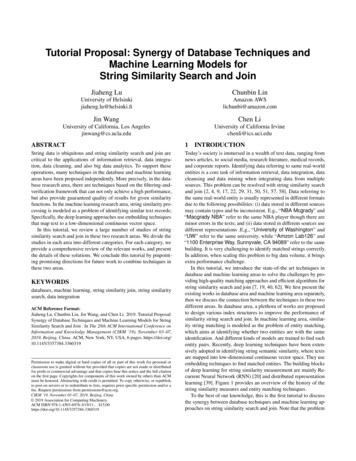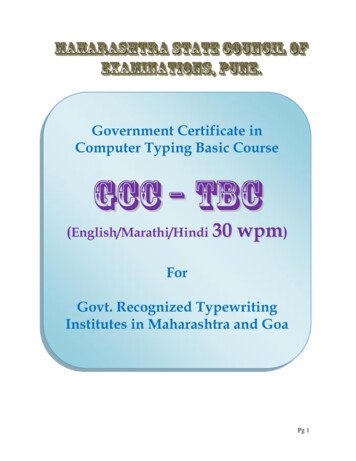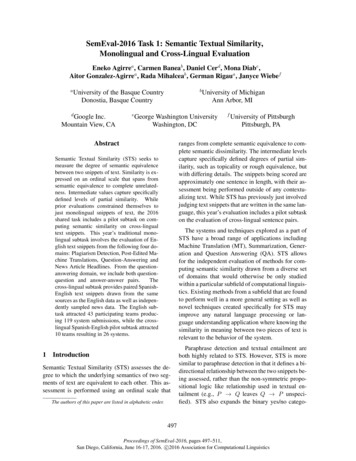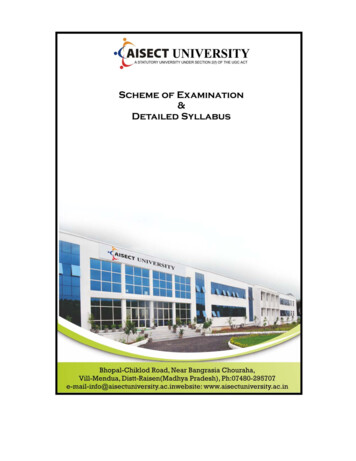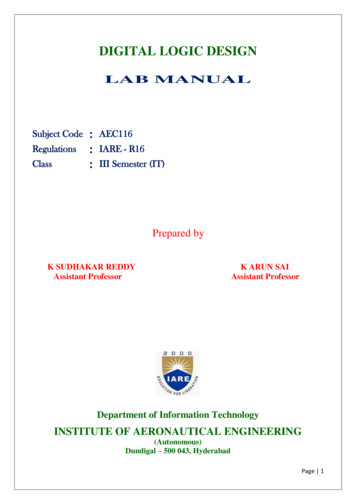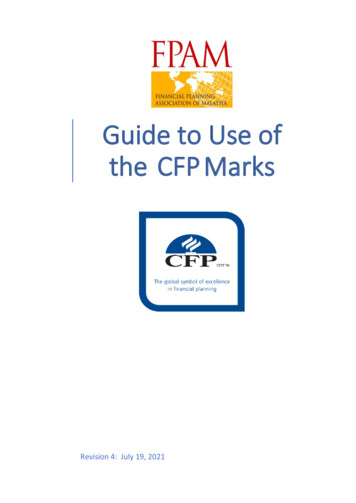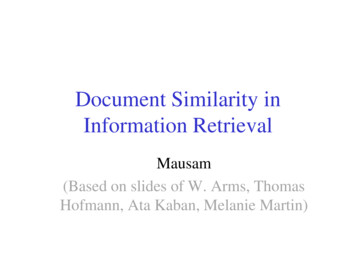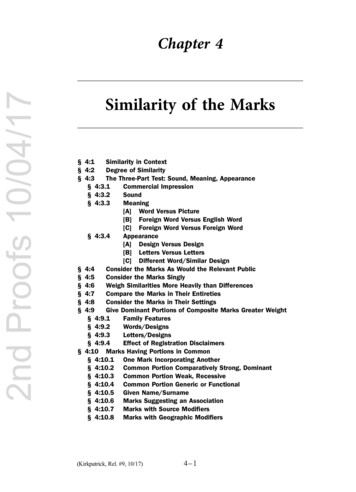
Transcription
2nd Proofs 10/04/17Chapter 4Similarity of the Marks§ 4:1Similarity in Context§ 4:2Degree of Similarity§ 4:3The Three-Part Test: Sound, Meaning, Appearance§ 4:3.1Commercial Impression§ 4:3.2Sound§ 4:3.3Meaning[A] Word Versus Picture[B] Foreign Word Versus English Word[C] Foreign Word Versus Foreign Word§ 4:3.4Appearance[A] Design Versus Design[B] Letters Versus Letters[C] Different Word/Similar Design§ 4:4Consider the Marks As Would the Relevant Public§ 4:5Consider the Marks Singly§ 4:6Weigh Similarities More Heavily than Differences§ 4:7Compare the Marks in Their Entireties§ 4:8Consider the Marks in Their Settings§ 4:9Give Dominant Portions of Composite Marks Greater Weight§ 4:9.1Family Features§ 4:9.2Words/Designs§ 4:9.3Letters/Designs§ 4:9.4Effect of Registration Disclaimers§ 4:10 Marks Having Portions in Common§ 4:10.1 One Mark Incorporating Another§ 4:10.2 Common Portion Comparatively Strong, Dominant§ 4:10.3 Common Portion Weak, Recessive§ 4:10.4 Common Portion Generic or Functional§ 4:10.5 Given Name/Surname§ 4:10.6 Marks Suggesting an Association§ 4:10.7 Marks with Source Modifiers§ 4:10.8 Marks with Geographic Modifiers(Kirkpatrick, Rel. #9, 10/17)4–1
2nd Proofs 10/04/17§ 4:1§§§§4:114:124:134:14§ 4:1LIKELIHOODOFCONFUSIONReversal of ElementsThe Familiar Versus the UnfamiliarParodyCombining Complainant’s MarksSimilarity in ContextSimilarity of the marks is an analytical factor in every court.1 (Seesection 2:4.) If this is the factor “without which the others have noprobative value,”2 then it is “the most important consideration, for it isin [the] similarity [of the marks] that the roots of the confusion lie.”31.2.3.The similarity factor is built into the registration statute, 15 U.S.C. § 1052(d),which prohibits registration of any mark “which so resembles” anothername or mark “as to be likely . . . to cause confusion.” Seemingly morerestrictive, the registered mark infringement statute, 15 U.S.C. § 1114,prohibits the use of “any reproduction, counterfeit, copy, or colorableimitation” that is likely to cause confusion. All four terms seem to implythat the registered mark somehow be the intended target or model for theinfringer, but the statute has not been so restrictively applied, since it iswell established that one may infringe a mark without knowledge of it orintent to infringe. (See section 8:1.) By contrast, the unregistered markinfringement statute, 15 U.S.C. § 1125(a), more generally prohibits theuse of “any word, term, name, symbol or device, or any combinationthereof,” which is likely to cause confusion.Sleeper Lounge Co. v. Bell Mfg. Co., 253 F.2d 720, 723, 117 U.S.P.Q. 117(9th Cir. 1958), distinguished in Jada Toys, Inc. v. Mattel, Inc., 496 F.3d974, 980, 83 U.S.P.Q.2d 1591 (9th Cir. 2007); see Golden Door, Inc. v.Odisho, 646 F.2d 347, 351, 208 U.S.P.Q. 638, 642 (9th Cir. 1980) (“somefactors are entitled to greater weight than others. For instance, thesimilarity of any competing marks is of substantial importance”); FordMotor Co. v. Summit Motor Prods., Inc., 930 F.2d 277, 293, 18 U.S.P.Q.2d1417, 1430, 1434 (3d Cir. 1991) (“Perhaps the most important of thesefactors. . . . Highly probative”), cited in Fisons Horticulture, Inc. v. VigoroIndus., Inc., 30 F.3d 466, 31 U.S.P.Q.2d 1592, 1599 n.11 (3d Cir. 1994)(“We have emphasized the importance of the similarity of the marks inlikelihood of confusion [citing Ford], but we have not ranked the factorsotherwise”).Armstrong Cork Co. v. World Carpets, Inc., 597 F.2d 496, 501, 203U.S.P.Q. 19 (5th Cir. 1979); Hewlett-Packard Co. v. Packard Press, 281F.3d 1261, 1265, 62 U.S.P.Q.2d 1001, 1003 (Fed. Cir. 2002) (“a predominant inquiry”); GoTo.com v. Walt Disney, 202 F.3d 1199, 53 U.S.P.Q.2d1652, 1656 (9th Cir. 2000) (similarity of marks “has always been considered a critical question in the likelihood of confusion analysis”); Brookfield v. W. Coast, 174 F.3d 1036, 1054, 50 U.S.P.Q.2d 1545 (9th Cir. 1999)(“the similarity of the marks will always be an important factor”); King ofthe Mountain Sports v. Chrysler Corp., 185 F.3d 1084, 1090, 51U.S.P.Q.2d 1349 (10th Cir. 1999); USA Network v. Gannett Co., 5844–2
2nd Proofs 10/04/17Similarity of the Marks§ 4:1Thus “[s]imilarity of the marks is a hallmark of consumer confusion.”4Without a threshold similarity of the marks that might result inconfusion, it may even be unnecessary to weigh the other factors.5However, the overall likelihood of confusion analysis generallyshould not be collapsed into the similarity factor alone. 6 Other factorsremain, and the crucial question is not merely whether the marks are4.5.6.F. Supp. 195, 223 U.S.P.Q. 678, 681 (D. Colo. 1984) (“seminal factor”);Lambda Elecs. Corp. v. Lambda Tech., Inc., 515 F. Supp. 915, 925, 211U.S.P.Q. 75, 85 (S.D.N.Y. 1981) (“It scarcely need be stated that thelikelihood of confusion that exists in any case will be a function of thedegree of similarity between the senior user ’s marks and the junior user ’sallegedly infringing uses.”); Frito-Lay v. Bachman Co., 704 F. Supp. 432,435, 14 U.S.P.Q.2d 1027, 1030 (S.D.N.Y. 1989) (similarity of marks“a fundamental Polaroid factor”). See section 2:3.Al-Site Corp. v. VSI Int’l, Inc., 174 F.3d 1308, 1330, 50 U.S.P.Q.2d 1161(Fed. Cir. 1999); Hornady Mfg. Co. v. Doubletap, Inc., 746 F.3d 995, 1001,110 U.S.P.Q.2d 1140 (10th Cir. 2014) (the “first and most importantfactor”) (see illustration, Appendix A24).Brookfield v. W. Coast, 174 F.3d 1036, 1054, 50 U.S.P.Q.2d 1545 (9th Cir.1999) (“Where the two marks are entirely dissimilar, there is no likelihoodof confusion. PEPSI does not infringe Coca-Cola’s COKE. Nothing furtherneed be said.”); Dippin’ Dots v. Frosty Bites, 369 F.3d 1197, 1208–09, 70U.S.P.Q.2d 1707, 1714 (11th Cir. 2004) (logos “overwhelmingly dissimilar”); Abercrombie & Fitch v. Am. Eagle Outfitters, 280 F.3d 619, 647–48,61 U.S.P.Q.2d 1769, 1788 (6th Cir. 2002); Am. Cyanamid Corp. v.Connaught Labs., Inc., 800 F.2d 306, 231 U.S.P.Q. 128, 130 (2d Cir.1986); Odom’s Tenn. Pride Sausage, Inc. v. FF Acquisition, L.L.C., 600 F.3d1343, 1346, 93 U.S.P.Q.2d 2030, 2032 (Fed. Cir. 2010) (cartoon designs;“unquestionably different commercial impressions”) (see illustration,Appendix A20); Omega SA v. Alpha Phi Omega, 118 U.S.P.Q.2d 1289,1293 (T.T.A.B. 2016); Kellogg Co. v. Pack’em Enters., Inc., 951 F.2d 330, 21U.S.P.Q.2d 1142, 1145 (Fed. Cir. 1991); Sun-Fun Prods., Inc. v. SuntanResearch & Dev., Inc., 656 F.2d 186, 189, 213 U.S.P.Q. 91, 93–94 (5th Cir.1981) (“The two marks must bear some threshold resemblance in order totrigger inquiry into extrinsic factors”); Universal City Studios, Inc. v.Nintendo Co., 746 F.2d 112, 116, 223 U.S.P.Q. 1000, 1003 (2d Cir.1984); Mfg. Co. v. Trainer, 101 U.S. 51, 56 (1880) (“The two labels areso unalike in every particular . . . that it is impossible that anyone can bemisled. . . . The whole structure of the case thus falls to the ground.”);First Brands Corp. v. Fred Meyer, Inc., 809 F.2d 1378, 1384, 1 U.S.P.Q.2d1779, 1783 (9th Cir. 1987), quoting Freixenet, S.A. v. Admiral Wine &Liquor Co., 731 F.2d 148, 222 U.S.P.Q. 770, 773 (3d Cir. 1984) (“labels . . .so dissimilar as to rule out any possibility of confusion”); Alchemy II, Inc.v. Yes! Entm’t Corp., 844 F. Supp. 560, 30 U.S.P.Q.2d 1770, 1776 (C.D. Cal.1994); Jada Toys, Inc. v. Mattel, Inc., 496 F.3d 974, 83 U.S.P.Q.2d 1591(9th Cir. 2007); see Paulsson Geophysical Servs., Inc. v. Sigmar, 529 F.3d303, 86 U.S.P.Q.2d 1813 (5th Cir. 2008) (use of “the exact same mark”justified limited “digits of confusion” analysis).AMF, Inc. v. Sleekcraft Boats, 599 F.2d 341, 350, 204 U.S.P.Q. 808, 816(9th Cir. 1979) (“Viewing the foundational question as one of ‘confusingsimilarity’ is improper because it merges analysis of one of the preliminaryinquiries with the conceptually distinct step of applying the statutorystandard.’”); see Int’l Data Grp., Inc. v. J&R Elecs., Inc., 798 F. Supp. 135,(Kirkpatrick, Rel. #9, 10/17)4–3
2nd Proofs 10/04/17§ 4:1LIKELIHOODOFCONFUSIONsimilar, but whether the similarity is likely to cause confusion. 7 Evenclose similarity is not in and of itself dispositive; confusion ultimatelymay be deemed unlikely once the other factors have been considered. 8Identical marks may coexist in remote fields. (See section 5:1.2.)The other factors come into play in various ways. Similaritycannot be assessed without reference to the strength of plaintiff ’s mark(see sections 3:2–3:3):If the similarity between two marks would lead consumers toexpect that they identify the same source, that similarity is likelyto cause confusion. If the similarity between the two markswould lead consumers to assume the similar marks were chosenbecause they describe similar, desirable attributes of the products,the similarity is less likely to invite a mistaken assumption that9the products must come from the same source.Also as to the strength factor, the degree of similarity of the marksin issue governs the relevance of more or less similar third-partymarks. (See section 3:6.2.)7.8.9.139 n.4 (S.D.N.Y. 1992) (“Courts have minimized the importance of thesimilarity factor.”), aff ’d without opinion, 986 F.2d 499 (2d Cir. 1992). Seesection 1:1.4.Brennan’s, Inc. v. Brennan’s Rest., L.L.C., 360 F.3d 125, 133, 69U.S.P.Q.2d 1939, 1944 (2d Cir. 2004); W. Publ’g Co. v. Rose Art Indus.,910 F.2d 57, 15 U.S.P.Q.2d 1545, 1548 (2d Cir. 1990), citing McGregorDoniger, Inc. v. Drizzle, Inc., 599 F.2d 1126, 202 U.S.P.Q. 81, 89 (2d Cir.1979); cf. Nautilus v. Icon, 372 F.3d 1330, 1344, 71 U.S.P.Q.2d 1173, 1184(Fed. Cir. 2004) (“The Ninth Circuit has never held that, in addition toconsidering the Sleekcraft factors, a court must satisfy itself that a separatecausal relationship exists between the similarity of the marks and consumer confusion.”).Astra Pharm. Prods., Inc. v. Beckman Instruments, Inc., 718 F.2d 1201, 220U.S.P.Q. 786, 790 (1st Cir. 1983); Jada Toys, Inc. v. Mattel, Inc., 496 F.3d974, 83 U.S.P.Q.2d 1591 (9th Cir. 2007) (“we have never countenanced alikelihood of confusion determination based on a consideration of dissimilarity alone . . .”); amended by 518 F.3d 628, 85 U.S.P.Q.2d 1895 (9th Cir.2008); Fortres Grand Corp. v. Warner Bros. Entm’t Inc., 763 F.3d 696, 112U.S.P.Q.2d 1154 (7th Cir. 2014) (similarity “not enough” when “juxtaposedagainst the weakness of all the other factors”); J.B. Williams Co. v. Le ConteCosmetics, Inc., 523 F.2d 187, 192, 189 U.S.P.Q. 10, 14 (9th Cir. 1975);McGregor-Doniger, Inc. v. Drizzle, Inc., 599 F.2d 1126, 1130, 202 U.S.P.Q.81, 89 (2d Cir. 1979); Lindy Pen Co. v. Bic Pen Corp., 725 F.2d 1240, 226U.S.P.Q. 17, 20 (9th Cir. 1984); Lever Bros. Co. v. Am. Bakeries Co., 693 F.2d251, 257, 216 U.S.P.Q. 177, 182 (2d Cir. 1982) (“Even close similaritybetween two marks is not dispositive”); In re Thor Tech Inc., 113 U.S.P.Q.2d1546, 1547 (T.T.A.B. 2015) (“[T]he identity of the marks alone is not sufficient to establish likelihood of confusion in the absence of probative evidencethat the goods are related. If that were the case, then the Registrant wouldhave rights in gross, and that is against the principles of trademark law.”).TCPIP Holding Co. v. Haar Commc’ns, 244 F.3d 88, 101, 57 U.S.P.Q.2d1969 (2d Cir. 2001).4–4
2nd Proofs 10/04/17Similarity of the Marks§ 4:1“[S]imilarity is not a binary factor but is a matter of degree.” 9.1 Themore similar the marks, the less similarity of the goods is required tosupport finding of likelihood of confusion—a “viable relationship”between the goods may suffice.10 Conversely, where the goods orservices are more closely related or competitive and travel throughthe same channels to the same consumers, the similarity of marksfactor may gather importance,11 and the less similarity of the marks isrequired.12As for the degree of care factor, consumers are less likely to perceiveor remember specific details of marks for low-cost shelf goods,13 but9.1.10.11.12.13.In re St. Helena Hosp., 774 F.3d 747, 752, 113 U.S.P.Q.2d 1082 (Fed. Cir.2014) (quoting In re Coors Brewing Co., 343 F.3d 1340, 1344 (Fed. Cir.2003)).In re Opus One, 60 U.S.P.Q.2d 1812, 1815 (T.T.A.B. 2001); In reConcordia Int’l Forwarding Corp., 222 U.S.P.Q. 355, 356 (T.T.A.B.1983); Mobil Oil Corp. v. Pegasus Petroleum Corp., 818 F.2d 254, 2U.S.P.Q.2d 1677, 1680 (2d Cir. 1987), citing SquirtCo. v. Seven-Up Co.,628 F.2d 1086, 1091, 207 U.S.P.Q. 897, 900 (8th Cir. 1980); In re EngineSupply, Inc., 225 U.S.P.Q. 216, 217 (T.T.A.B. 1985) (citing cases); In reShell Oil Co., 992 F.2d 1204, 1207, 26 U.S.P.Q.2d 1687, 1689 (Fed. Cir.1993) (“even when goods or services are not competitive or intrinsicallyrelated, the use of identical marks can lead to the assumption that there isa common source”); TMEP 1207.01(a) (2009).Checkpoint v. Check Point, 269 F.3d 270, 60 U.S.P.Q.2d 1609, 1614(3d Cir. 2001).La Quinta Worldwide LLC v. Q.R.T.M., S.A. de C.V., 762 F.3d 867 (9th Cir.2014); Sun Banks of Fla., Inc. v. Sun Fed. Sav. & Loan Ass’n, 651 F.2d 311,318, 211 U.S.P.Q. 844, 850 (5th Cir. 1981) (“With this similarity of servicecomes the potential for the public’s mistaken assumption of connexitybetween the providers of related services. The more likely the public is tomake such an association, the less similarity in the marks is needed for afinding of likelihood of confusion.”), citing Am. Steel Foundries v. Robertson,269 U.S. 372 (1926); Beer Nuts, Inc. v. Clover Club Foods Co., 805 F.2d 920,925, 231 U.S.P.Q. 913, 916 (10th Cir. 1986) (“a small degree of similaritybetween two marks may lead to a finding that confusion is likely when theproducts are identical, inexpensive items”); In re L.C. Licensing, Inc., 49U.S.P.Q.2d 1379, 1381 (T.T.A.B. 1998); Quadrex Corp. v. Inficon LeyboldHeraeus, Inc., 228 U.S.P.Q. 300, 303 (T.T.A.B. 1985) (“the degree ofsimilarity in the goods is inversely proportional to the degree of similarityin the marks”); Jules Berman & Assoc., Inc. v. Consol. Distilled Prods., Inc.,202 U.S.P.Q. 67 (T.T.A.B. 1979); TMEP 1207.01(b) (2009).B.V.D. Licensing Corp. v. Body Action Design, Inc., 846 F.2d 727, 6U.S.P.Q.2d 1719, 1722 (Fed. Cir. 1988) (Nies, J., dissenting), citingColgate-Palmolive Co. v. Purex Corp., 451 F.2d 1401, 172 U.S.P.Q. 176(C.C.P.A. 1971); AM Gen. Corp. v. DaimlerChrysler Corp., 311 F.3d 796, 828,65 U.S.P.Q.2d 1001, 1023 (7th Cir. 2002) (“Visual similarity may havegreater importance when the products are low-priced items not likely toreceive considerable study from the consumer.”); Kemp v. Bumble Bee, 398F.3d 1049, 1055, 73 U.S.P.Q.2d 2002, 2007 (8th Cir. 2005). See section 6:4.(Kirkpatrick, Rel. #9, 10/17)4–5
2nd Proofs 10/04/17§ 4:2LIKELIHOODOFCONFUSIONwhen the goods are relatively expensive, even a very similar mark maynot cause confusion.14Actual confusion may belie arguments that the marks are notconfusingly similar.15§ 4:2Degree of SimilarityMarks need not be identical to be in conflict.16 The test is one ofresemblance.17 “What degree of resemblance is necessary to constitutean infringement is incapable of exact definition, as applicable to allcases.”18 “[S]imilarity is not a binary factor but is a matter of degree.”19“There is no simple rule as to when marks are too similar.”2014.15.16.17.18.19.20.Beer Nuts, Inc. v. Clover Club Foods Co., 805 F.2d 920, 925, 231 U.S.P.Q.913, 916 (10th Cir. 1986); cf. Teledyne Techs. Inc. v. W. Skyways Inc., 78U.S.P.Q.2d 1203 (T.T.A.B. 2006) (likelihood of confusion found betweenidentical marks for airplane engines and airplane engine parts; no actualconfusion for ten years).Beacon v. Onebeacon, 376 F.3d 8, 18, 71 U.S.P.Q.2d 1641 (1st Cir. 2004);Jada Toys, Inc. v. Mattel, Inc., 496 F.3d 974, 83 U.S.P.Q.2d 1591 (9th Cir. 2007).Louis Vuitton Malletier v. Dooney & Bourke, Inc., 454 F.3d 108, 117, 79U.S.P.Q.2d 1481 (2d Cir. 2006); Louis Vuitton Malletier v. Burlington CoatFactory Warehouse Corp., 426 F.3d 532, 538 n.3, 76 U.S.P.Q.2d 1852,1856 n.3 (2d Cir. 2005); Saxlehner v. Eisner & Mendelson Co., 179 U.S.19, 33 (1900) (“It is not necessary to constitute an infringement that everyword of a trademark should be appropriated. It is sufficient that enough betaken to deceive the public in the purchase of a protected article.”); McLeanv. Fleming, 96 U.S. 245, 255 (1878) (“that requirement would alwaysenable the wrong-doer to evade responsibility for his wrongful acts”);Xtreme Lashes, LLC v. Xtended Beauty, Inc., 576 F.3d 221, 229, 91U.S.P.Q.2d 1385, 1388 (5th Cir. 2009) (“Even if a person recognized thatthe marks are not identical, she might believe that XTENDED BEAUTY is aproduct line offered by the makers of XTREME LASHES, such as a discountline. Confusion of origin, not the identity of marks, is the gravamen oftrademark infringement.”); Cullman Ventures, Inc. v. Columbian Art Works,Inc., 717 F. Supp. 96, 128, 13 U.S.P.Q.2d 1257, 1281 (S.D.N.Y. 1989) (“Aninfringer is not absolved from liability merely because it has not replicatedevery single aspect of a trademark”); Gracie v. Gracie, 217 F.3d 1060, 1067,55 U.S.P.Q.2d 1256 (9th Cir. 2000).15 U.S.C. § 1052(d) (prohibiting registration of a mark “which so resembles” another name or mark “as to be likely . . . to cause confusion”);Syntex Labs., Inc. v. Norwich Pharmacal Co., 315 F. Supp. 45, 166U.S.P.Q. 312, 315–16 (S.D.N.Y. 1970), aff ’d, 437 F.2d 566, 169 U.S.P.Q.1 (2d Cir. 1971); Am. Steel Foundries v. Robertson, 269 U.S. 372, 381(1926) (injunction “where the resemblance is so close as to be likely toproduce confusion”).Country Floors, Inc. v. Gepner, 930 F.2d 1056, 1064, 18 U.S.P.Q.2d 1577,1584 (3d Cir. 1991), quoting McLean v. Fleming, 96 U.S. 245, 251 (1878).In re Coors Brewing Co., 343 F.3d 1340, 1344, 68 U.S.P.Q.2d 1059 (Fed.Cir. 2003).Kos v. Andrx, 369 F.3d 700, 713, 70 U.S.P.Q.2d 1874, 1885 (3d Cir. 2004).4–6
2nd Proofs 10/04/17Similarity of the Marks§ 4:3.1Generally, the more similar the marks, the more confusion islikely.21 Identity of the marks, especially when the senior mark isinherently strong, can weigh heavily against the junior user, evenwhen the goods or services are not competitive or intrinsically related.22[W]here there are significant differences in the design of the twomarks, the finding of similarity is a less important factor inestablishing a likelihood of confusion than it would be if the twomarks had been identical in design or nearly indistinguishable to a23casual observer.§ 4:3The Three-Part Test: Sound, Meaning, Appearance§ 4:3.1Commercial ImpressionThe standard analysis compares the marks in sound, meaning andappearance;24 these are the primary ways in which marks are “encountered in the marketplace.”25 As a separate element or “proxy” forthe sum of the three, one compares “the overall impression createdby the designations as they are used in marketing. . . .” 26 Similarity is21.22.23.24.25.26.Kibler v. Hall, 843 F.3d 1068, 1077, 121 U.S.P.Q.2d 1069 (6th Cir. 2016)(“The more similar the marks are, the more likely it is that relevantconsumers will confuse their sources.”); Brookfield v. W. Coast, 174 F.3d1036, 1054, 50 U.S.P.Q.2d 1545 (9th Cir. 1999) (“the more similar themarks in terms of appearance, sound, and meaning, the greater thelikelihood of confusion”); Exxon Corp. v. Tex. Motor Exch. of Houston,Inc., 628 F.2d 500, 208 U.S.P.Q. 384, 388 (5th Cir. 1980); Country Floors,Inc. v. Mizak, 29 U.S.P.Q.2d 1468, 1471 (D. Conn. 1993) (“it is, of course,an inescapable conclusion that the greater the similarity between theplaintiff ’s and defendant’s marks, the greater the likelihood of confusionamong consumers”); Ocean Bio-Chem, Inc. v. Turner Network Television,Inc., 741 F. Supp. 1546, 16 U.S.P.Q.2d 1264, 1270 (S.D. Fla. 1990); MCA,Inc. v. Mid-Continent Adjustment Co., 8 U.S.P.Q.2d 1840, 1844 (N.D. Ill.1988).In re Majestic, 315 F.3d 1311, 1316, 65 U.S.P.Q.2d 1201, 1204 (Fed. Cir.2003).In re Coors Brewing Co., 343 F.3d 1340, 1344, 68 U.S.P.Q.2d 1059 (Fed.Cir. 2003).Jet, Inc. v. Sewage Aeration Sys., 165 F.3d 419, 49 U.S.P.Q.2d 1355, 1358(6th Cir. 1999); Miss World (U.K.) Ltd. v. Mrs. Am. Pageants, Inc., 856 F.2d1445, 1450, 8 U.S.P.Q.2d 1237, 1241 (9th Cir. 1988); Giant Food, Inc. v.Nation’s Foodservice, Inc., 710 F.2d 1565, 218 U.S.P.Q. 390, 395 (Fed. Cir.1983); John H. Harland Co. v. Clarke Checks, Inc., 711 F.2d 966, 975, 219U.S.P.Q. 515, 524 (11th Cir. 1983); Henri’s Food Prods. Co. v. Kraft, Inc.,717 F.2d 352, 220 U.S.P.Q. 386, 388 (7th Cir. 1983).Universal Money Ctrs., Inc. v. Am. Tel. & Tel. Co., 22 F.3d 1527, 30U.S.P.Q.2d 1930, 1933 (10th Cir. 1994); Heartsprings, Inc. v. Heartspring,Inc., 143 F.3d 550, 46 U.S.P.Q.2d 1481, 1483 (10th Cir. 1998).R ESTATEMENT (T HIRD ) OF U NFAIR C OMPETITION § 21(a)(i) (1995);GoTo.com, Inc. v. Walt Disney Co., 202 F.3d 1199, 53 U.S.P.Q.2d 1652(9th Cir. 2000) (“With a single glance at the two images, one is immediately(Kirkpatrick, Rel. #9, 10/17)4–7
2nd Proofs 10/04/17§ 4:3.1LIKELIHOODOFCONFUSIONnot to be considered in the abstract, but from the ordinary consumer ’sperspective.27The facts permitting, each facet should be considered. 28 Similarityof any one permits but does not require a finding that the marks areconfusingly similar.29In appropriate cases, two marks may be found to be confusinglysimilar if there are sufficient similarities in terms of sound or visualappearance or connotation. Of course, two marks may be extremelysimilar or even identical in one aspect (sound, appearance or27.28.29.struck by their similarity.”) (see illustration, Appendix A21); W.W.W.Pharm. Co. v. Gillette Co., 984 F.2d 567, 25 U.S.P.Q.2d 1593, 1597(2d Cir. 1993) (“general impression”); UMG Recordings Inc. v. O’Rourke,92 U.S.P.Q.2d 1042, 1048–49 (T.T.A.B. 2009) (“When comparing themarks, we must consider the appearance, sound, connotation and commercial impression of each mark . . . . The overall commercial impressionsof the marks is [sic] a consideration occasionally used as a proxy for theultimate conclusion of similarity or dissimilarity. In the case at hand . . .we specifically consider commercial impression as a distinct considerationwhen comparing the marks.”) (internal quotation marks omitted); E. & J.Gallo Winery v. Gallo Cattle Co., 955 F.2d 1327, 21 U.S.P.Q.2d 1824,1832 (9th Cir. 1992); Palm Bay v. Veuve Clicquot, 396 F.3d 1369, 1372,73 U.S.P.Q.2d 1689, 1692 (Fed. Cir. 2005) (“the phrase ‘commercialimpression’ is occasionally used as a proxy for the ultimate conclusion ofsimilarity or dissimilarity of marks resulting from a comparison of theirappearance, sound, and meaning”); Giant Food, Inc. v. Nation’s Foodservice, Inc., 710 F.2d 1565, 218 U.S.P.Q. 390, 395 (Fed. Cir. 1983); TMEP1207.01(b) (2009) (“the emphasis must be on the recollection of the averagepurchaser who normally retains a general, rather than specific, impression oftrademarks”).Reno Air Racing Ass’n v. McCord, 452 F.3d 1126, 1136–37, 79 U.S.P.Q.2d1431 (9th Cir. 2006); In re I.Am.Symbolic, LLC, 116 U.S.P.Q.2d 1406,1409 (T.T.A.B. 2015).AMF, Inc. v. Sleekcraft Boats, 599 F.2d 341, 204 U.S.P.Q. 808, 816 (9th Cir.1979); Recot v. Becton, 214 F.3d 1322, 1329, 54 U.S.P.Q.2d 1894 (Fed. Cir.2000) (“All relevant facts pertaining to appearance, sound and connotationmust be considered before similarity as to one or more of these factors maybe sufficient to support a finding that the marks are similar or dissimilar.”).Volkswagenwerk AG v. Wheeler, 814 F.2d 812, 817, 2 U.S.P.Q.2d 1264,1268 (1st Cir. 1987) (appearance alone); Ralston Purina Co. v. On-CorFrozen Foods, Inc., 746 F.2d 801, 223 U.S.P.Q. 979, 980 (Fed. Cir. 1984);United Glob. Media Grp., Inc. v. Tseng, 112 U.S.P.Q.2d 1039, 1047(T.T.A.B. 2014) (“any one of these means of comparison may be critical”);In re White Swan, Ltd., 8 U.S.P.Q.2d 1534, 1535 (T.T.A.B. 1988); In reLamson Oil Co., 6 U.S.P.Q.2d 1041, 1042 n.4 (T.T.A.B. 1987); In reAquamar, Inc., 115 U.S.P.Q.2d 1122, 1127 (T.T.A.B. 2015) (“[E]quivalencyin connotation does not, in and of itself, determine the question oflikelihood of confusion in this case . . . the similarity in connotationmust be viewed as but a single factor in the overall evaluation of likelihoodof confusion.”) (quoting In re Ithaca Indus., 230 U.S.P.Q. 702, 704(T.T.A.B. 1986)).4–8
2nd Proofs 10/04/17Similarity of the Marks§ 4:3.1connotation), and yet not be confusingly similar because of signifi30cant differences in one or more of the other two aspects.Visual dissimilarity may outweigh aural similarity depending onthe circumstances of sale;31 for example, appearance may be the moreimportant where the goods are sold in self-service markets.32 Orsimilarity of sound may trump visual dissimilarities. 33Where the marks in dispute are common words with well-knownmeanings, relatively slight differences in sound or appearance suffice toavoid conflict in some cases.34 By contrast, where the marks in issue arecoined, a lesser degree of similarity of sound or appearance has beenrequired to establish likelihood of confusion.35 “Two names that lookand sound similar will naturally seem even more similar where there30.31.32.33.34.35.Kabushiki Kaisha Hattori Seiko v. Satellite Int’l Ltd., 29 U.S.P.Q.2d 1317,1318 (T.T.A.B. 1991), aff ’d without opinion, 979 F.2d 216 (Fed. Cir. 1992)(emphasis in original; citation omitted); TMEP 1207.01(b)(i) (2009).Del Labs., Inc. v. Alleghany Pharmacal Corp., 516 F. Supp. 777, 215U.S.P.Q. 421, 426 (S.D.N.Y. 1981); Mem Co. v. Yardley of London, Inc.,212 U.S.P.Q. 280, 284 (S.D.N.Y. 1981); Heartsprings, Inc. v. Heartspring,Inc., 143 F.3d 550, 46 U.S.P.Q.2d 1481, 1483 (10th Cir. 1998); ViacomInt’l, Inc. v. Komm, 46 U.S.P.Q.2d 1233, 1238 (T.T.A.B. 1998).One Indus., LLC v. Jim O’Neal Distrib., Inc., 578 F.3d 1154, 1162 (9th Cir.2009) (as buyers select the goods “inside a store or during online browsing, sightis significantly more important when comparing these marks than sound ormeaning”) (emphasis in original); Del Labs., Inc. v. Alleghany Pharmacal Corp.,516 F. Supp. 777, 215 U.S.P.Q. 421, 426 (S.D.N.Y. 1981), quoting SpanglerCandy Co. v. Crystal Pure Candy Co., 235 F. Supp. 18, 22, 143 U.S.P.Q. 94(N.D. Ill. 1964), aff’d, 353 F.2d 641, 147 U.S.P.Q. 434 (7th Cir. 1965).All. Bank v. New Century Bank, 742 F. Supp. 2d 532, 98 U.S.P.Q.2d 1292(E.D. Pa. 2010) (CUSTOMER FIRST versus CUSTOMERS 1st)(see illustration, Appendix A15).Playboy Enters., Inc. v. Chuckleberry Publ’g, Inc., 486 F. Supp. 414, 206U.S.P.Q. 70, 76 (S.D.N.Y. 1980), citing cases; E.R. Squibb & Sons, Inc. v.Cooper Labs., 536 F. Supp. 523, 214 U.S.P.Q. 441, 450 (S.D.N.Y. 1982);Racemark Int’l, Inc. v. Specialty Prods., Inc., 217 U.S.P.Q. 772, 779(N.D.N.Y. 1982) (RACEMARK v. ROSSMARK); Chesebrough-Pond’s,Inc. v. Faberge, Inc., 666 F.2d 393, 214 U.S.P.Q. 44, 48 (9th Cir. 1982)(MATCH v. MATCHO); Swatch AG v. Beehive Wholesale, LLC, 739 F.3d150, 159 (4th Cir. 2014) (SWAP versus SWATCH, both for watches) (seeillustration, Appendix A25); Ava Enters., Inc. v. P.A.C. Trading Grp., Inc.,86 U.S.P.Q.2d 1659 (T.T.A.B. 2008) (BOSS v. BOOSTER).See E.I. du Pont de Nemours & Co. v. Yoshida Int’l, Inc., 393 F. Supp. 502,185 U.S.P.Q. 597, 604 (E.D.N.Y. 1975) (TEFLON v. EFLON); Procter &Gamble Co. v. Johnson & Johnson, 485 F. Supp. 1185, 1197, 205 U.S.P.Q.697, 709 (S.D.N.Y. 1979) (“When arbitrary or fanciful marks are involved,the distinctiveness of the marks will make the public more conscious ofsimilarities than differences.”), aff ’d without opinion, 636 F.2d 1203 (2dCir. 1980), cited in Inter IKEA Sys. B.V. v. Akea, LLC, 110 U.S.P.Q.2d1734, 1741 (T.T.A.B. 2014). See the hypothetical illustration in TCPIPHolding Co. v. Haar Commc’ns, 244 F.3d 88, 101, 57 U.S.P.Q.2d 1969 (2dCir. 2001).(Kirkpatrick, Rel. #9, 10/17)4–9
2nd Proofs 10/04/17§ 4:3.2LIKELIHOODOFCONFUSIONare no differences in meaning to distinguish them. Nor can thesimilarity of coined marks be explained by, or ameliorated by virtue of,any relationship between the marks and the products identified.”36§ 4:3.2SoundThe sounds of two marks may create a confusingly similar impression when heard.37 The sounds must be compared as if heard singly,subject to the consumer ’s indefinite recollection. According to onecourt, it is an “accepted fact that people develop biases to particularsounds which they have heard over a long period of time and which theyexpect to hear in the future such that a word which sounds similar to theword people expect to hear can be easily perceived as the word the peopleexpect to hear and not the word which was actually said.”38Because a trademark owner cannot control how its mark will bevocalized, there is not necessarily one, correct pronunciation, especially where the mark is coined or unusual. Nor is there any rulefor gauging how a mark will sound.39 “[I]t is impossible to predicthow the public will pronounce a particular mark.” 40 “Prospectivepurchasers do not necessarily speak the word portions of marksthe way advertising agencies or manufacturers would have themspoken”; purchasers who have only seen the mark in a particularform may have never heard or spoken it.41 Evidence, as always, is36.37.38.39.40.41.Kos v. Andrx, 369 F.3d 700, 713, 70 U.S.P.Q.2d 1874, 1885 (3d Cir. 2004)(ADVICOR v. ALTOCOR).AMF, Inc. v. Sleekcraft Boats, 599 F.2d 341, 204 U.S.P.Q. 808, 817 (9th Cir.1979), quoting G.D. Searle & Co. v. Chas. Pfizer & Co., 265 F.2d 385, 387,121 U.S.P.Q. 74, 75–76 (7th Cir. 1959); Grotrian, Helfferich, Schulz,Th. Steinweg Nachf. v. Steinway & Sons, 523 F.2d 1331, 1340, 186U.S.P.Q. 436, 443 (2d Cir. 1975); In re Energy Telecomms. & Elec.Ass’n, 222 U.S.P.Q. 350, 351 (T.T.A.B. 1983).Pathfinder Commc’ns Corp. v. Midwest Commc’ns Co., 593 F. Supp. 281,284, 224 U.S.P.Q. 203, 205 (N.D. Ill. 1984); see, e.g., Orkin ExterminatingCo. v. Parrill, 223 U.S.P.Q. 564, 566 (S.D. W. Va. 1983) (ORKIN v. ORKO;differences in second syllables not as likely to be picked up once the “earfocuses” on the same, distinctive first syllable).Smithkline Beckman Corp. v. Procter & Gamble Co., 591 F. Supp. 1229,223 U.S.P.Q. 1230, 1237 (N.D.N.Y. 1984); ConAgra, Inc. v. Saavedra,4 U.S.P.Q.2d 1245, 1247 (T.T.A.B. 1987); In re Lamson Oil Co., 6U.S.P
Thus "[s]imilarity of the marks is a hallmark of consumer confusion."4 Without a threshold similarity of the marks that might result in confusion, it may even be unnecessary to weigh the other factors.5 However, the overall likelihood of confusion analysis generally


